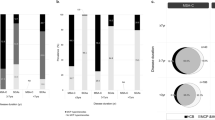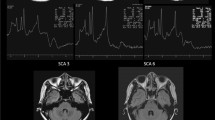Abstract
Aim
The second consensus statement for the diagnosis of multiple system atrophy type cerebellar (MSA-C) includes pons and middle cerebellar peduncle (MCP) atrophy as MRI features. However, other MRI abnormalities such as MCP hyperintensity, hot cross bun sign (HCB), putaminal hypointensity and hyperintense putaminal rim have been described.
Objectives
To evaluate, in patients with sporadic late-onset cerebellar ataxia (SLOCA), the discriminative value of several MRI features for the diagnosis of MSA-C, to follow their evolution during the course of MSA-C, and to search for correlations between these MRI features and clinical signs.
Methods
Consecutive patients referred for SLOCA underwent comprehensive clinical evaluation and laboratory investigations, brain MRI, DaTscan and a 1-year follow-up.
Results
Among 80 patients, 26 had MSA-C, 22 another diagnosis, and 32 no diagnosis at the end of the follow-up. At baseline, MCP hyperintensity and HCB were more frequent in patients finally diagnosed with MSA-C than in other patients with SLOCA (p < 0.0001), and had the highest specificity (98.5%) and positive predictive value (91.7%) for the diagnosis of MSA-C, compared to all other MRI signs. The most relevant MRI sequence regarding HCB sign was the T2-proton density (DP) weighted. All MRI features were more frequent with disease duration. No correlation was found between any MRI feature and neither clinical data, nor dopaminergic neuronal loss (p = 0.5008), except between vermis atrophy and UPDRSIII score.
Conclusion
MCP hyperintensity and HCB sign should be added into the list of additional features of possible MSA-C. MRI signal abnormalities suggestive of MSA-C should be searched for in suitable sequence.



Similar content being viewed by others
References
Gebus O, Montaut S, Monga B, Wirth T, Cheraud C, Rego AC, Zinchenko I, Carré G, Hamdaoui M, Hautecloque G, Nguyen-Them L, Lannes B, Chanson JB, Lagha-Boukbiza O, Fleury MC, Devys D, Nicolas G, Rudolf G, Bereau M, Mallaret M, Renaud M, Acquaviva M, Koenig M, Koob M, Kremer S, Namer IJ, Cazeneuve C, -Laguna A, Tranchant C, Anheim M (2017) Deciphering the causes of sporadic late-onset cerebellar ataxias: a prospective study with implications for diagnostic work. J Neurol 264(6):1118–1126
Hadjivassiliou M, Martindale J, Shanmugarajah P, Grünewald RA, Sarrigiannis PG, Beauchamp N, Garrard K, Warburton R, Sanders DS, Friend D, Duty S, Taylor J, Hoggard N (2017) Causes of progressive cerebellar ataxia: prospective evaluation of 1500 patients. J Neurol Neurosurg Psychiatry 88(4):301–309
Gilman S, Wenning GK, Low PA, Brooks DJ, Mathias CJ, Trojanowski JQ, Wood NW, Colosimo C, Dürr A, Fowler CJ, Kaufmann H, Klockgether T, Lees A, Poewe W, Quinn N, Revesz T, Robertson D, Sandroni P, Seppi K, Vidailhet M (2008) Second consensus statement on the diagnosis of multiple system atrophy. Neurology 71(9):670–676
Lewinski F, Werner C, Jörn T, Mohr A, Sixel-Döring F, Trenkwalder C (2007) T2*-weighted MRI in diagnosis of multiple system atrophy: a practical approach for clinicians. J Neurol 254(9):1184–1188
Righini A, Antonini A, Ferrarini M, de Notaris R, Canesi M, Triulzi F, Pezzoli G (2002) Thin section MR study of the basal ganglia in the differential diagnosis between striatonigral degeneration and Parkinson disease. J Comput Assist Tomogr 26(2):266–271
Lee EA, Cho HI, Kim SS, Lee WY (2004) Comparison of magnetic resonance imaging in subtypes of multiple system atrophy. Parkinsonism Relat Disord 10(6):363–368
Bhattacharya K, Saadia D, Eisenkraft B, Yahr M, Olanow W, Drayer B, Kaufmann H (2002) Brain magnetic resonance imaging in multiple-system atrophy and Parkinson disease: a diagnostic algorithm. Arch Neurol 59(5):835–842
Nicoletti G, Fera F, Condino F, Auteri W, Gallo O, Pugliese P, Arabia G, Morgante L, Barone P, Zappia M, Quattrone A (2006) MR imaging of middle cerebellar peduncle width: differentiation of multiple system atrophy from Parkinson disease. Radiology 239(3):825–830
Seppi K, Schocke MFH, Prennschuetz-Schuetzenau K, Mair KJ, Esterhammer R, Kremser C, Muigg A, Scherfler C, Jaschke W, Wenning GK, Poewe W (2006) Topography of putaminal degeneration in multiple system atrophy: a diffusion magnetic resonance study. Mov Disord Off J Mov Disord Soc 21(6):847–852
Bürk K, Bühring U, Schulz JB, Zühlke C, Hellenbroich Y, Dichgans J (2005) Clinical and magnetic resonance imaging characteristics of sporadic cerebellar ataxia. Arch Neurol 62(6):981–985
Lee W-H, Lee C-C, Shyu W-C, Chong P-N, Lin S-Z (2005) Hyperintense putaminal rim sign is not a hallmark of multiple system atrophy at 3T. AJNR Am J Neuroradiol 26(9):2238–2242
-Metz M, Naumann M, Csoti I, Solymosi L (2001) Measurement of the midbrain diameter on routine magnetic resonance imaging: a simple and accurate method of differentiating between Parkinson disease and progressive supranuclear palsy. Arch Neurol 58(7):1076–1079
Anheim M, Lagier-Tourenne C, Stevanin G, Fleury M, Durr A, Namer IJ, Denora P, Brice A, Mandel JL, Koenig M, Tranchant C (2009) SPG11 spastic paraplegia. A new cause of juvenile parkinsonism. J Neurol 256(1):104–108
Murata Y, Yamaguchi S, Kawakami H, Imon Y, Maruyama H, Sakai T, Kazuta T, Ohtake T, Nishimura M, Saida T, Chiba S, Oh-I T, Nakamura S (1998) Characteristic magnetic resonance imaging findings in Machado-Joseph disease. Arch Neurol 55(1):33–37
Namekawa M, Honda J, Shimazaki H (2015) “Hot Cross Bun” sign associated with SCA1. Intern Med 54(7):859–860
Bürk K, Skalej M, Dichgans J (2001) Pontine MRI hyperintensities (“the cross sign”) are not pathognomonic for multiple system atrophy (MSA). Mov Disord Off J Mov Disord Soc 16(3):535
Sugiyama A, Ito S, Suichi T, Sakurai T, Mukai H, Yokota H, Yonezu T, Kuwabara S (2015) Putaminal hypointensity on T2*-weighted MR imaging is the most practically useful sign in diagnosing multiple system atrophy: a preliminary study. J Neurol Sci 349(1–2):174–178
Deguchi K, Ikeda K, Kume K, Takata T, Kokudo Y, Kamada M, Touge T, Honjo N, Masaki T (2015) Significance of the hot-cross bun sign on T2*-weighted MRI for the diagnosis of multiple system atrophy. J Neurol 262(6):1433–1439
Kasahara S, Miki Y, Kanagaki M, Kondo T, Yamamoto A, Morimoto E, Okadaa T, Itoc H, Takahashic H, Togashi K (2012) “Hot cross bun” sign in multiple system atrophy with predominant cerebellar ataxia: A comparison between proton density-weighted imaging and T2-weighted imaging. Eur J Radiol 81(10):2848–2852
Schrag A, Good CD, Miszkiel K, Morris HR, Mathias CJ, Lees AJ, Quinn NP (2000) Differentiation of atypical parkinsonian syndromes with routine MRI. Neurology 54(3):697–702
Schrag A, Kingsley D, Phatouros C, Mathias CJ, Lees AJ, Daniel SE, Quinn NP (1998) Clinical usefulness of magnetic resonance imaging in multiple system atrophy. J Neurol Neurosurg Psychiatry 65(1):65–71
Lin DJ, Hermann KL, Schmahmann JD (2016) The diagnosis and natural history of multiple system atrophy, cerebellar type. Cerebellum 15(6):663–679
Pradhan S, Tandon R (2017) Relevance of non-specific MRI features in multiple system atrophy. Clin Neurol Neurosurg 159:29–33
Burk K (2004) MRI-based volumetric differentiation of sporadic cerebellar ataxia. Brain 127(1):175–181
Abe K, Hikita T, Yokoe M, Mihara M, Sakoda S (2006) The “cross” signs in patients with multiple system atrophy: a quantitative study. J Neuroimaging 16(1):73–77
Horimoto Y, Aiba I, Yasuda T, Ohkawa Y, Katayama T, Yokokawa Y, Goto A, Ito Y (2002) Longitudinal MRI study of multiple system atrophy—when do the findings appear, and what is the course? J Neurol 249(7):847–854
Konagaya M, Konagaya Y, Iida M (1994) Clinical and magnetic resonance imaging study of extrapyramidal symptoms in multiple system atrophy. J Neurol Neurosurg Psychiatry 57(12):1528–1531
Wakai M, Kume A, Takahashi A, Ando T, Hashizume Y (1994) A study of parkinsonism in multiple system atrophy: clinical and MRI correlation. Acta Neurol Scand 90(4):225–231
Wenning GK, Tison F, Shlomo Y, Daniel SE, Quinn NP (1997) Multiple system atrophy: a review of 203 pathologically proven cases. Mov Disord 12(2):133–147
Mestre TA, Gupta A, Lang AE (2016) MRI signs of multiple system atrophy preceding the clinical diagnosis: the case for an imaging-supported probable MSA diagnostic category. J Neurol Neurosurg Psychiatry 87(4):443–444
Antonini A, Benti R, De Notaris R, Tesei S, Zecchinelli A, Sacilotto G, Meucci N, Canesi M, Mariani C, Pezzoli G, Gerundini P (2003) 123I-Ioflupane/SPECT binding to striatal dopamine transporter (DAT) uptake in patients with Parkinson’s disease, multiple system atrophy, and progressive supranuclear palsy. Neurol Sci 24(3):149–150
Pirker W, Asenbaum S, Bencsits G, Prayer D, Gerschlager W, Deecke L, Brücke T (2000) [123I]beta-CIT SPECT in multiple system atrophy, progressive supranuclear palsy, and corticobasal degeneration. Mov Disord Off J Mov Disord Soc 15(6):1158–1167
Muñoz E, Iranzo A, Rauek S, Lomeña F, Gallego J, Ros D, Santamaría J, Tolosa E (2011) Subclinical nigrostriatal dopaminergic denervation in the cerebellar subtype of multiple system atrophy (MSA-C). J Neurol 258(12):2248–2253
Funding
This research did not receive any specific grant from funding agencies in the public, commercial, or not-for-profit sectors.
Author information
Authors and Affiliations
Corresponding author
Ethics declarations
Conflicts of interest
The authors declare that they have no conflict of interest.
Ethical approval
This study has been approved by the local ethical committee.
Electronic supplementary material
Below is the link to the electronic supplementary material.
415_2020_9702_MOESM1_ESM.pdf
Figure 1: Scale for the Assessment and Rating of Ataxia (SARA) with disease duration in group 1. Each point is the average value obtained when considering all the data obtained for MSA-C patients (PDF 10 kb)
415_2020_9702_MOESM2_ESM.pdf
Figure 2: Spinocerebellar Degeneration Functional Score (SDFS) with disease duration in group 1. Each point is the average value obtained when considering all the data obtained for MSA-C patients. (PDF 9 kb)
415_2020_9702_MOESM3_ESM.pdf
Figure 3: Unified Parkinson’s Disease Rating Scale III (UPDRS III) with disease duration in group 1. Each point is the average value obtained when considering all the data obtained for MSA-C patients. (PDF 10 kb)
Rights and permissions
About this article
Cite this article
Carré, G., Dietemann, J.L., Gebus, O. et al. Brain MRI of multiple system atrophy of cerebellar type: a prospective study with implications for diagnosis criteria. J Neurol 267, 1269–1277 (2020). https://doi.org/10.1007/s00415-020-09702-w
Received:
Revised:
Accepted:
Published:
Issue Date:
DOI: https://doi.org/10.1007/s00415-020-09702-w




